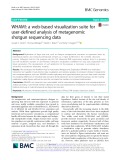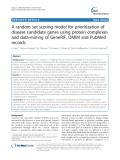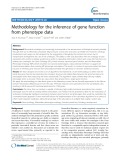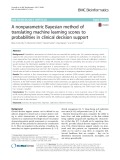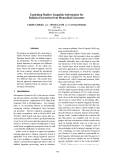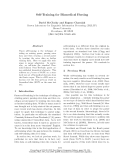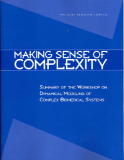
Biomedical data sets
-
Exploration of large data sets, such as shotgun metagenomic sequence or expression data, by biomedical experts and medical professionals remains as a major bottleneck in the scientific discovery process. Although tools for this purpose exist for 16S ribosomal RNA sequencing analysis, there is a growing but still insufficient number of user-friendly interactive visualization workflows for easy data exploration and figure generation. The development of such platforms for this purpose is necessary to accelerate and streamline microbiome laboratory research.
 11p
11p  vibeauty
vibeauty
 23-10-2021
23-10-2021
 10
10
 1
1
 Download
Download
-
Prioritizing genetic variants is a challenge because disease susceptibility loci are often located in genes of unknown function or the relationship with the corresponding phenotype is unclear. A global data-mining exercise on the biomedical literature can establish the phenotypic profile of genes with respect to their connection to disease phenotypes.
 13p
13p  vikentucky2711
vikentucky2711
 26-11-2020
26-11-2020
 10
10
 1
1
 Download
Download
-
Biomedical ontologies are increasingly instrumental in the advancement of biological research primarily through their use to efficiently consolidate large amounts of data into structured, accessible sets. However, ontology development and usage can be hampered by the segregation of knowledge by domain that occurs due to independent development and use of the ontologies.
 15p
15p  vikentucky2711
vikentucky2711
 26-11-2020
26-11-2020
 9
9
 1
1
 Download
Download
-
Inference of active regulatory cascades under specific molecular and environmental perturbations is a recurring task in transcriptional data analysis. Commercial tools based on large, manually curated networks of causal relationships offering such functionality have been used in thousands of articles in the biomedical literature.
 15p
15p  vioklahoma2711
vioklahoma2711
 19-11-2020
19-11-2020
 12
12
 1
1
 Download
Download
-
Probabilistic assessments of clinical care are essential for quality care. Yet, machine learning, which supports this care process has been limited to categorical results. To maximize its usefulness, it is important to find novel approaches that calibrate the ML output with a likelihood scale.
 12p
12p  viflorida2711
viflorida2711
 30-10-2020
30-10-2020
 16
16
 1
1
 Download
Download
-
The ability to efficiently search and filter datasets depends on access to high quality metadata. While most biomedical repositories require data submitters to provide a minimal set of metadata, some such as the Gene Expression Omnibus (GEO) allows users to specify additional metadata in the form of textual key-value pairs (e.g. sex: female).
 12p
12p  viflorida2711
viflorida2711
 30-10-2020
30-10-2020
 13
13
 1
1
 Download
Download
-
With the exponential growth in available biomedical data, there is a need for data integration methods that can extract information about relationships between the data sets. However, these data sets might have very different characteristics. For interpretable results, data-specific variation needs to be quantified.
 9p
9p  viconnecticut2711
viconnecticut2711
 28-10-2020
28-10-2020
 12
12
 0
0
 Download
Download
-
With modern methods in biotechnology, the search for biomarkers has advanced to a challenging statistical task exploring high dimensional data sets. Feature selection is a widely researched preprocessing step to handle huge numbers of biomarker candidates and has special importance for the analysis of biomedical data. Such data sets often include many input features not related to the diagnostic or therapeutic target variable.
 21p
21p  vicolorado2711
vicolorado2711
 22-10-2020
22-10-2020
 17
17
 0
0
 Download
Download
-
We propose an approach for extracting relations between entities from biomedical literature based solely on shallow linguistic information. We use a combination of kernel functions to integrate two different information sources: (i) the whole sentence where the relation appears, and (ii) the local contexts around the interacting entities. We performed experiments on extracting gene and protein interactions from two different data sets. The results show that our approach outperforms most of the previous methods based on syntactic and semantic information. ...
 8p
8p  bunthai_1
bunthai_1
 06-05-2013
06-05-2013
 39
39
 1
1
 Download
Download
-
Parser self-training is the technique of taking an existing parser, parsing extra data and then creating a second parser by treating the extra data as further training data. Here we apply this technique to parser adaptation. In particular, we self-train the standard Charniak/Johnson Penn-Treebank parser using unlabeled biomedical abstracts. This achieves an f -score of 84.3% on a standard test set of biomedical abstracts from the Genia corpus. This is a 20% error reduction over the best previous result on biomedical data (80.2% on the same test set). ...
 4p
4p  hongphan_1
hongphan_1
 15-04-2013
15-04-2013
 40
40
 1
1
 Download
Download
-
This report documents a recent workshop1 at which approximately 85 biomedical scientists, math- ematicians, and statisticians shared their experiences in modeling aspects of cellular function, disease states, and neuroscience. The topics were chosen to provide a sampling of the rapidly emerging research at the interface of the mathematical and biomedical sciences, and this summary has been prepared as an introduction to those topics for mathematical scientists who are exploring the opportunities from bio- medical science.
 48p
48p  layon_5
layon_5
 29-03-2013
29-03-2013
 41
41
 4
4
 Download
Download
CHỦ ĐỀ BẠN MUỐN TÌM








